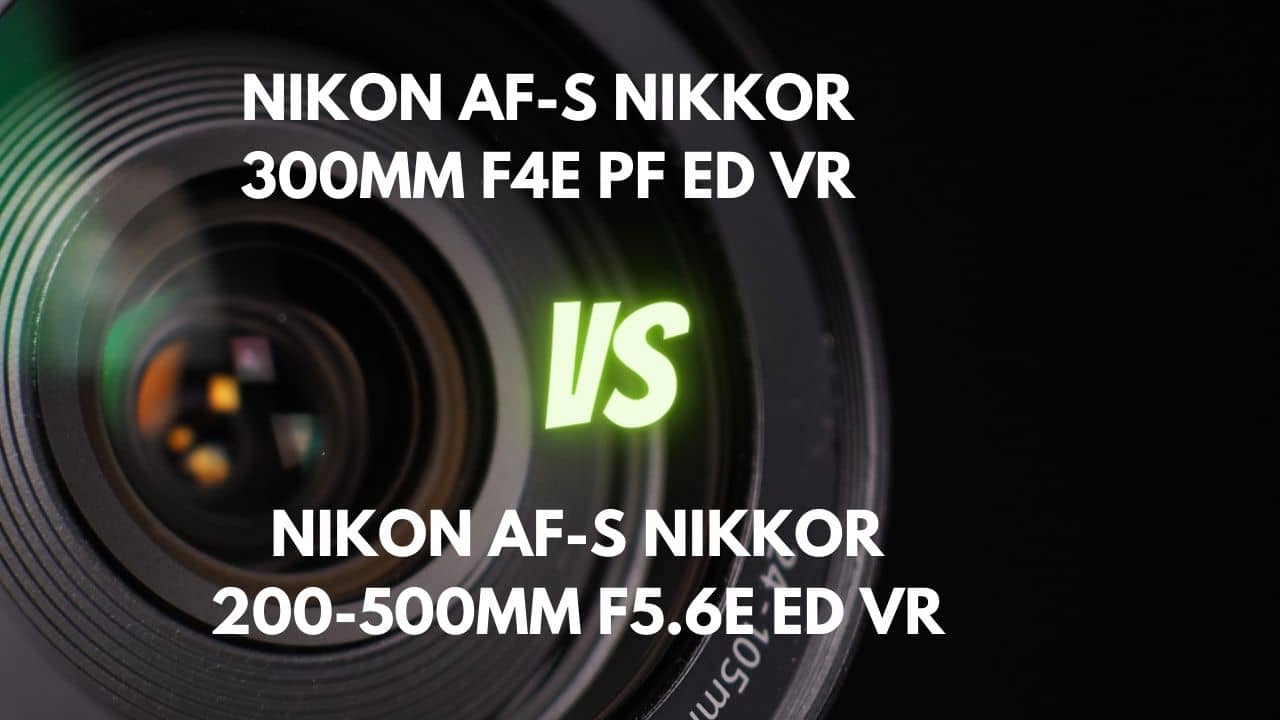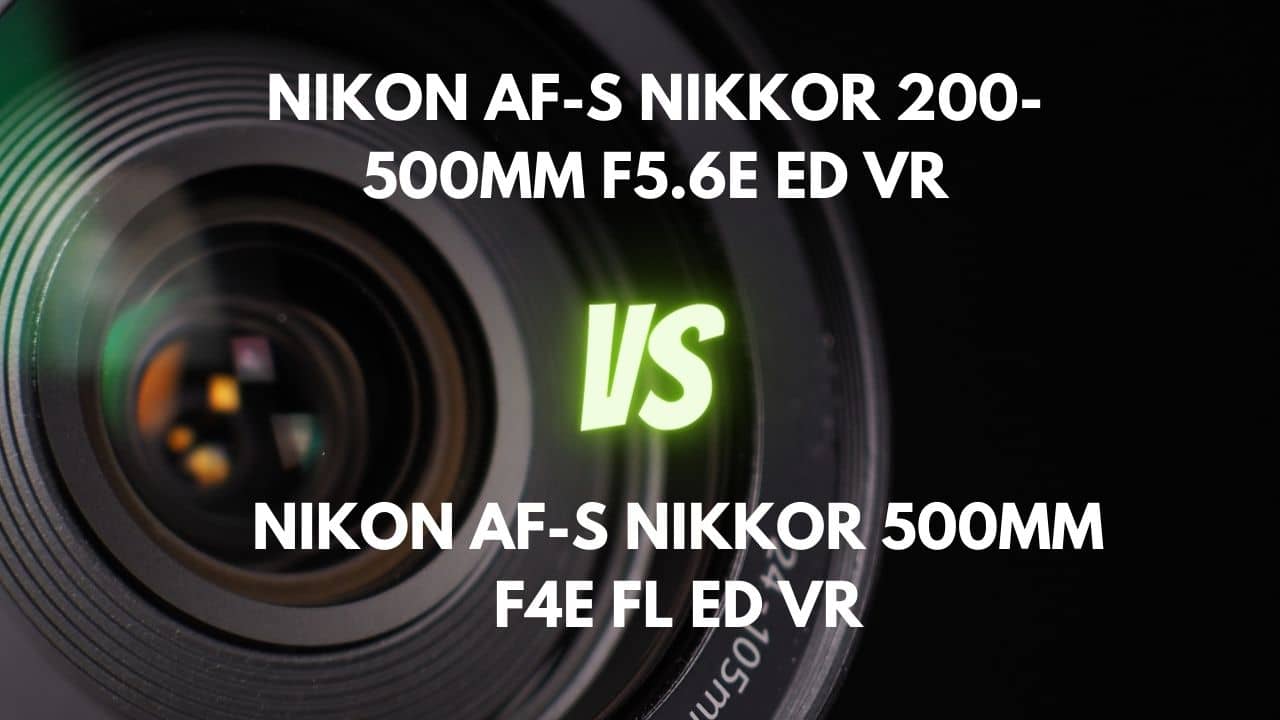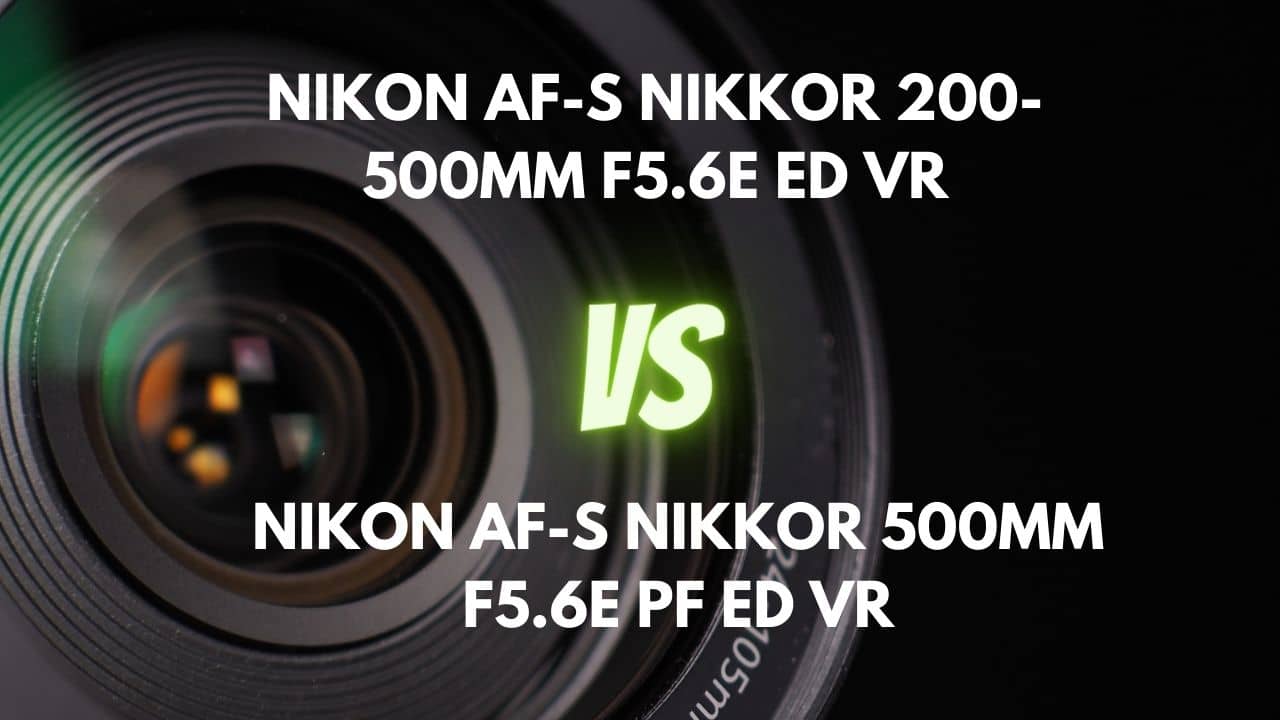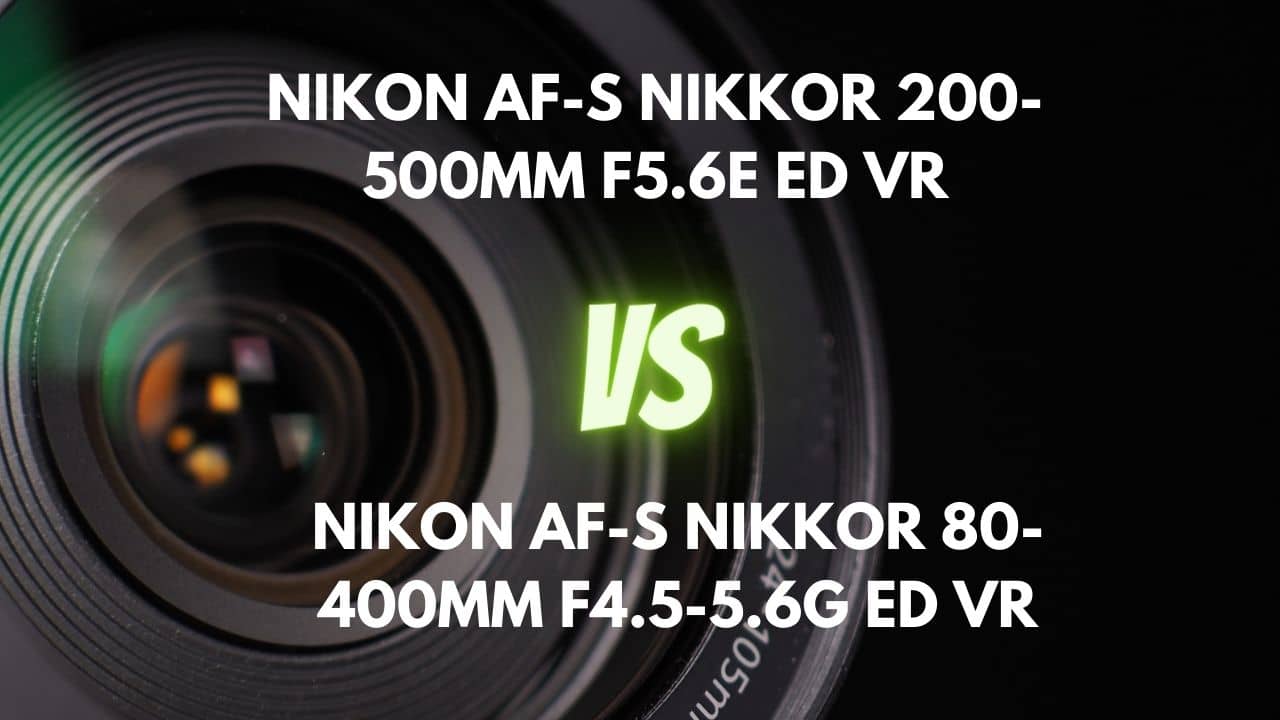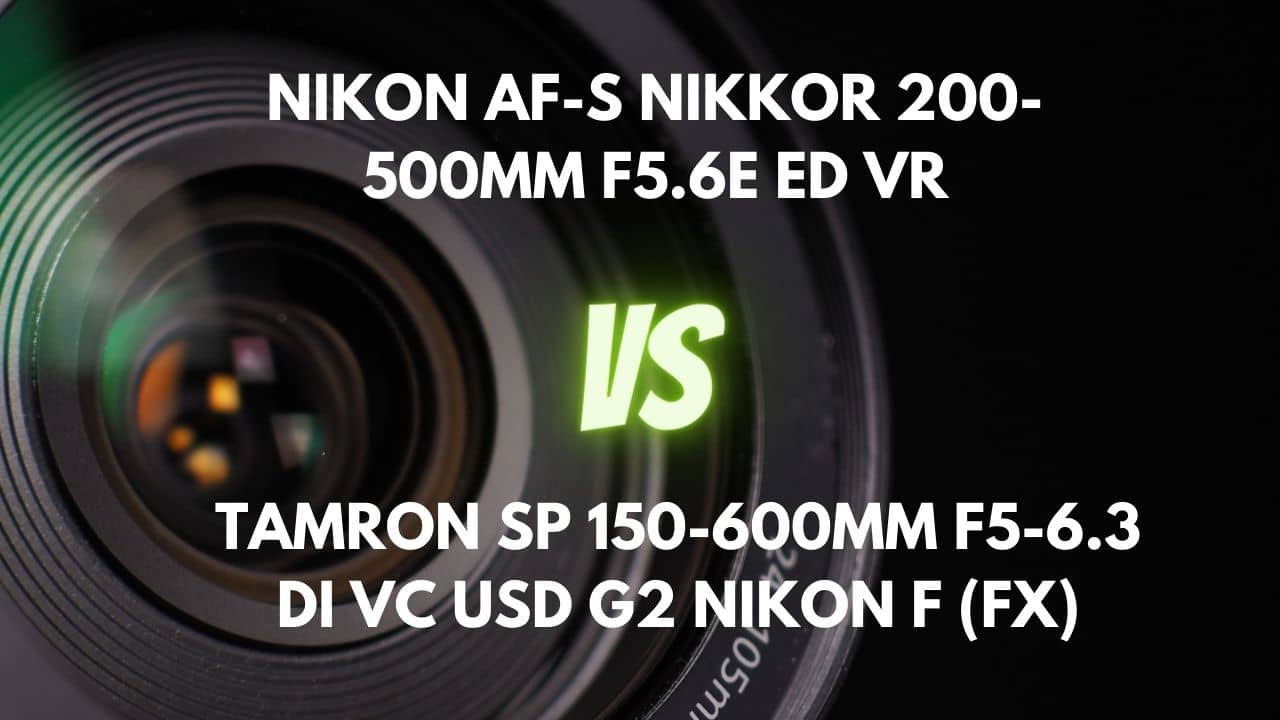Are you an avid sports or wildlife photographer seeking the perfect lens to capture those breathtaking moments?
In this article, we’ll compare two exceptional contenders in the world of telephoto lenses: the Nikon 200-500mm f/5.6 and the Sigma 100-400mm f/5-6.3 Contemporary. We understand that choosing the right lens is crucial for capturing sharp, vibrant, and visually stunning images in various challenging conditions, whether it’s an exhilarating sports event or an elusive wildlife scene.
Our in-depth comparison will help you navigate the key features and benefits of each lens, such as focal range, aperture, image stabilization, sharpness, bokeh quality, and more. We’ll also delve into factors like portability, construction, tripod collar design, and focusing performance, ensuring you have a comprehensive understanding of what each lens brings to the table.
Whether you prioritize image quality, versatility, or portability, this article will guide you to make an informed decision that caters to your unique photography needs.
So, grab your camera and let’s embark on this exciting journey to find the ideal telephoto lens for your sports and wildlife photography adventures!
Overview
| Nikon AF-S NIKKOR 200-500mm F5.6E ED VR | Sigma 100-400mm F5-6.3 DG OS HSM Nikon F (FX) | |
|---|---|---|
| Max Aperture | F5.6 | F5-6.3 |
| Aperture Type | Fixed | Variable |
| Focal Range (mm) | 200-500 | 100-400 |
| Mount Type | Nikon F (FX) | Nikon F (FX) |
| Zoom Ratio (X) | 2.5 | 4 |
Comparing the Nikon 200-500mm f/5.6 and the Sigma 100-400mm f/5-6.3 Contemporary, we can see that the Nikon lens has a fixed aperture of f/5.6, while the Sigma lens has a variable aperture ranging from f/5 to f/6.3. Fixed aperture lenses like the Nikon lens offer consistent performance across the entire zoom range, better low light performance, and generally higher optical quality. On the other hand, variable aperture lenses like the Sigma lens are usually more affordable and lighter in weight.
The Nikon lens has a focal range of 200-500mm, making it more suitable for subjects at a greater distance, which can be advantageous for wildlife photography. The Sigma lens, with a focal range of 100-400mm, offers more versatility at the cost of reduced reach compared to the Nikon lens. Both lenses have a Nikon F (FX) mount type, making them compatible with Nikon full-frame cameras.
When considering sports and wildlife photography, the larger fixed aperture of the Nikon lens (f/5.6) can provide better low light performance and shallower depth of field, which is useful for isolating subjects from their background. The longer focal range (200-500mm) also makes it more suitable for capturing subjects at a greater distance.
Although the Sigma lens has a more versatile focal range (100-400mm), its variable aperture (f/5-6.3) may result in slightly reduced image quality and low light performance, especially at longer focal lengths.
In conclusion, for sports and wildlife photography, the Nikon lens with its fixed aperture, longer focal range, and better low light performance is likely to be the superior choice. However, the Sigma lens may be more appealing to those who prioritize budget and versatility, as well as those who require a wider focal range for different types of photography.
Design and Ease of Use
| Nikon AF-S NIKKOR 200-500mm F5.6E ED VR | Sigma 100-400mm F5-6.3 DG OS HSM Nikon F (FX) | |
|---|---|---|
| Diameter x Length (mm) | ⌀108×267.5mm | ⌀86×182mm |
| Weight (gr) | 2300 | 1160 |
| Filter Thread (mm) | 95 | 67 |
| Weather Sealing | No | Yes |
| Zoom Method | Rotary (extending) | Push/Pull (extending) |
| Distance Scale | Yes | No |
| DoF Scale | No | No |
| Hood Supplied | Yes | Yes |
| Hood Code | HB-71 | LH770-04 |
| Tripod Collar | Yes | Yes |
Comparing the Nikon 200-500mm f/5.6 and Sigma 100-400mm f/5-6.3 Contemporary, we can see that the Nikon lens has a larger diameter and length (⌀108×267.5mm) compared to the more compact Sigma lens (⌀86×182mm). In terms of weight, the Nikon lens is considerably heavier at 2300g, while the Sigma lens weighs only 1160g. A more compact and lightweight lens like the Sigma lens offers better portability, balance, discreetness, storage, and ease of lens swapping.
The Nikon lens features a rotary (extending) zoom method, whereas the Sigma lens employs a push/pull (extending) zoom method. Extending rotary zoom lenses like the Nikon lens tend to have simpler designs and can be lighter than internal rotary zoom lenses. Push/pull zoom lenses, like the Sigma lens, offer similar pros and cons, but the push/pull mechanism might be a matter of personal preference when it comes to handling.
In conclusion, the Sigma lens is the superior choice for photographers prioritizing portability, balance, and discreetness, thanks to its smaller size and lighter weight. However, the Nikon lens might be more suitable for those who don’t mind the additional weight and size in exchange for other factors such as image quality, aperture, or focal range.
Lens Mount and Barrel
The lens mount of Nikon 200-500mm f/5.6 is also made of metal but provides added protection with its own rubber gasket. In contrast, the lens mount of Sigma 100-400mm f/5-6.3 Contemporary is crafted from metal and features a rubber gasket to prevent dust and moisture from penetrating the mount. Both mounts exhibit durability and resistance to the elements, ensuring a secure connection between the lens and the camera body.
Regarding the lens barrels, the Nikon lens has an outer barrel made of metal with a high-grade plastic shell and an inner barrel made of plastic. This design allows for telescoping during zooming while offering a lock to maintain the shortest 200mm length. Although the Nikon lens becomes longer when zoomed in, it remains well-balanced with the camera. On the other hand, the Sigma lens boasts a high-quality plastic construction that provides a comfortable grip and a pleasant finish.
Plastic lens barrels, like the one in the Sigma lens, are generally lighter and more affordable, but they may be less durable over time. Metal lens barrels, such as the one found in the Nikon lens, are sturdier and offer a more professional feel but may be heavier and less portable.
In conclusion, The Nikon lens provides a more robust and durable construction, which may appeal to photographers seeking a professional feel and sturdiness. The Sigma lens, however, offer a lightweight and comfortable option for those who prioritize portability and affordability.
Weather Sealing
When comparing the Nikon 200-500mm f/5.6 and Sigma 100-400mm f/5-6.3 Contemporary in terms of weather sealing for sports and wildlife photography, it’s essential to consider their ability to withstand various environmental conditions.
The Nikon lens is not fully weather-sealed, but it does provide some elemental protection with a rubber gasket at the lens mount. However, the lens lacks internal seals and fluorine coating on the front element, which could make it more vulnerable to damage in extreme weather conditions.
On the other hand, the Sigma lens features a dust and splash-proof lens mount with a gasket to prevent dust and moisture penetration. While the Sigma lens isn’t fully weather-sealed either, it appears to offer better sealing than most budget-oriented lenses.
Weather sealing is particularly important in sports and wildlife photography, as photographers often work in unpredictable and harsh conditions. A fully weather-sealed lens provides better protection, durability, and performance in adverse environments. However, neither of these lenses is fully weather-sealed, and they may require additional precautions when used in challenging conditions.
Rings
When comparing the Nikon 200-500mm f/5.6 and Sigma 100-400mm f/5-6.3 Contemporary in terms of their rings, one should consider factors such as ergonomics, control, build quality, and ring placement.
The Nikon lens features two rings: a ribbed zoom ring and a textured rubber focus ring. Both rings are designed for smooth rotation and offer a quality feel. The zoom ring is positioned towards the front, taking almost 180 degrees of rotation to zoom between 200mm and 500mm.
The focus ring is closer to the camera body, providing an easy change of focal length while maintaining balance and grip. The lens also features a zoom lock switch and full-time manual focus override.
In contrast, the Sigma lens has a front-positioned zoom ring and rear-positioned focus ring, which may not be preferred by some users. The zoom ring has a ridged rubber surface and requires only around 90 degrees of rotation for full zoom. The lens also supports push/pull zooming with a specially designed lens hood.
The focus ring has a ridged surface but is plastic rather than rubber. The rotational resistance is good, but the ring’s flush position with the lens barrel can make it difficult to locate, especially when wearing gloves. The lens includes an extension lock switch on the zoom ring and a zoom lock switch at the 100mm setting.
In conclusion, the Nikon lens offers better ergonomics, with a more intuitive ring placement and comfortable grip. The smooth rotation and additional features like the zoom lock switch and full-time manual focus override make it a superior choice in terms of ring design.
However, the Sigma lens offers quicker zooming and the unique push/pull zooming feature, which might be preferred by some photographers.
Switches/Buttons
When comparing the Nikon 200-500mm f/5.6 and Sigma 100-400mm f/5-6.3 Contemporary based on their switches and buttons, it’s essential to consider their functionality, ease of use, and overall accessibility.
The Nikon lens comes with a quartet of switches, which include an AF/MF switch, a focus limiter switch, an IS switch, and a VR mode switch. By using the AF/MF switch, you can manually adjust focus even when autofocus is enabled. On the other hand, the focus limiter switch restricts the autofocus range to certain distances. With the IS switch, you can manage the vibration reduction system, while the VR mode switch allows you to switch between normal and sport mode.
On the other hand, the Sigma lens features a switch panel with four switches and a button. The switches consist of an AF/MF switch, a focus limiter switch with three independent settings, an image stabilization switch with two modes, and a custom switch for programmable settings via Sigma’s USB Dock. The switches have a solid click and are visually indicated with white backgrounds on the AF and lock switches. However, the short-throw 3-position switches may require extra care to avoid mispositioning when aiming for the middle setting.
In conclusion, both lenses offer a range of switches and buttons to accommodate various photography needs. The Nikon lens has an edge in terms of ease of use and accessibility, with switches that are straightforward to locate and operate. The Sigma lens provides additional customization options through its custom switch, which may appeal to photographers who prefer more personalized settings.
Filter Thread
The Nikon 200-500mm f/5.6 features a 95mm filter thread made from metal, ensuring durability and a secure fit for filters. When focusing, its front element and filter thread remain stationary, which is particularly useful when working with polarizers or graduated neutral density filters. This feature makes the lens more convenient and easier to handle while shooting. However, the 95mm size is less common, which may limit filter options and increase costs. Still, high-quality filters compatible with this lens are available from reputable brands like B+W and Hoya.
On the other hand, the Sigma 100-400mm f/5-6.3 Contemporary has a 67mm filter thread made from robust plastic, which is lightweight and easy to use with filters. The thread size is relatively small and common, making it easy to find and purchase filters for it. The thread is held in place with external Phillips screws and fits inside the included LH770-04 lens hood. However, the thickness of the lens barrel at the threads can make it challenging to access with fingertips, so a filter wrench is recommended, especially when using slim filters like circular polarizers.
In conclusion, both lenses offer unique advantages in terms of filter threads. The Nikon lens provides a more durable and stable metal filter thread, but its 95mm size may limit options and increase costs. The Sigma lens, with its 67mm plastic filter thread, offers compatibility with a wider range of filters at a lower cost. However, the thickness of the lens barrel may require additional tools for filter attachment and removal.
Lens Hood
The lens hood is of Nikon 200-500mm f/5.6 a one-piece plastic bayonet design that is included in the package. It is quite large, with a 5″ diameter and 4″ length, providing effective protection against flare and other elements. The hood can be reversed and put back on the lens for convenient transportation. Its smooth finish allows it to rotate smoothly for easy attachment and removal.
On the other hand, the lens hood of Sigma 100-400mm f/5-6.3 Contemporary is made of rigid plastic and features a ribbed interior to prevent light reflections from entering the lens, maintaining image contrast. The exterior is also ribbed, which aids in grip during installation and removal. The hood smoothly rotates and clicks into place securely, while the rear of the hood is substantially contoured, allowing for comfortable handling when using the lens’s push-pull zoom feature.
In conclusion, both lens hoods offer unique advantages. The Nikon lens hood has a simple design and is easy to use and transport due to its reversible feature. The Sigma lens hood, however, has a more sophisticated design with ribbing on both the interior and exterior surfaces, providing better grip and light reflection prevention. Additionally, the contoured rear of the Sigma lens hood allows for more comfortable push-pull zoom operation. Given these factors, the Sigma lens hood appears to be the superior option due to its enhanced design and functionality.
Tripod Collar
In the context of sports and wildlife photography, a reliable tripod collar is essential for stability and ease of use.
To help provide stability and support its weight when used with a tripod, the Nikon 200-500mm f/5.6 is equipped with a tripod collar. The collar is specifically designed to ensure that the lens remains steady and secure, helping you achieve sharp and well-defined images. The collar has a single point of connection located far on the back of the lens barrel, which could be improved by having a two-point stabilization system, similar to Kirk and RRS replacement lens collars.
Although the tripod collar of the Nikon lens is not natively compatible with Arca-Swiss, some photographers opt to swap it out for an aftermarket collar that can provide better support and compatibility. Doing so can help ensure that the lens remains stable and secure when mounted on a tripod, allowing you to capture high-quality images with ease. The tripod collar can be removed when not needed, allowing for more comfortable handheld use.
On the other hand, the Sigma 100-400mm f/5-6.3 Contemporary features an optional tripod mount ring, the Sigma TS-111 Tripod Socket, with built-in compatibility for Arca-Swiss clamps. The tripod ring attachment area is covered by the included Sigma PT-31 Protective Cover, which is a firm silicone ring that slides over the tripod mount ring guides and holds securely in place. The design of the tripod collar is well thought out, and it is easy to use.
In conclusion, both tripod collars have their merits, but the Sigma lens has a clear advantage in terms of compatibility and design. Its built-in compatibility with Arca-Swiss clamps, well-thought-out design, and the inclusion of the protective cover make it more user-friendly and versatile for sports and wildlife photographers.
The Nikon lens’s tripod collar may require an aftermarket replacement for improved support and compatibility, making the Sigma lens’s tripod collar the superior option for these types of photography.
Focusing and Optical Stabilization
| Nikon AF-S NIKKOR 200-500mm F5.6E ED VR | Sigma 100-400mm F5-6.3 DG OS HSM Nikon F (FX) | |
|---|---|---|
| Autofocus | Yes | Yes |
| AF Motor | Silent Wave Motor | Hyper Sonic Motor |
| Rotating Front Element | Does not rotate on focusing | Does not rotate on focusing |
| Min Focus Distance | 2.2m | 0.16m |
| Max Magnification (X) | 0.22 | 0.26 |
| Full-Time Manual Focus | Yes | Yes |
| Focus Method | Internal | Internal |
Focusing Performance
In sports and wildlife photography, focusing performance is crucial for capturing sharp images of fast-moving subjects.
The Nikon 200-500mm f/5.6 features a built-in Silent Wave Motor (SWM) that ensures quiet autofocus operation and allows for full-time manual focus override when set to the M/A position. Its autofocus speed is quite good, with initial focus acquisition being faster than many f/1.8 Nikon primes. At 500mm, the Nikon lens takes approximately 1 second to achieve focus from close range to infinity. At 300mm, this time is reduced to around 0.7 seconds. This quick and reliable autofocus performance can be especially useful when shooting subjects that are moving quickly or unpredictably, enabling you to capture sharp and well-focused shots with ease.
The Nikon lens offers decent low-light performance, although it may experience a slight slowdown at 500mm. The manual focus action is smooth, with a wide focus ring that allows for precise focus adjustment. With its internally focusing design, the Nikon lens ensures that the length remains constant and the front element does not rotate during focusing.
The Sigma 100-400mm f/5-6.3 Contemporary has a stepping motor-driven AF system that focuses very fast and quietly, with only a faint buzz heard in a quiet environment. The initial autofocus acquisition speed is solid, but low light AF performance is not stellar, as expected for a narrow max aperture lens.
The lens offers manual focus override in continuous-servo autofocus (AF-C) and the manual focus action is smooth. The lens can focus accurately in most situations, but in AI-Servo (AF-C continuous) focus, the accuracy is comparatively inconsistent. By restricting the autofocus range to specific distances, the focus limiter on the Nikon lens can help to significantly speed up focus acquisition.
In conclusion, both lenses have good focusing performance, but the Nikon lens has a slight edge in terms of speed, accuracy, and consistency, making it more suitable for sports and wildlife photography. The Sigma lens offers fast and quiet focusing, but its comparatively inconsistent accuracy in AI-Servo (AF-C continuous) focus may not be ideal for fast-moving subjects. Thus, the Nikon lens’s focusing performance is superior for sports and wildlife photographers who demand fast, accurate, and consistent autofocus.
Optical Stabilization
In sports and wildlife photography, optical stabilization is essential for capturing sharp images, especially when shooting handheld or in low-light conditions.
Equipped with an effective Vibration Reduction (VR) system, the Nikon 200-500mm f/5.6 can provide up to 4.5 stops of stabilization, helping you capture sharp and well-defined images even when shooting at slower shutter speeds. The system operates silently, making it ideal for both photography and video recording.
It offers two modes of stabilization: Normal and Sport, with the latter optimized for tracking fast-moving subjects. With the Vibration Reduction (VR) system engaged, the Nikon lens can produce usable shots at shutter speeds as slow as 1/60 seconds when shooting at 500mm focal length. In some cases, this can even be pushed down to 1/25 seconds, highlighting the impressive performance of the stabilization system.
The Sigma 100-400mm f/5-6.3 Contemporary incorporates powerful image stabilization that compensates for about 3 stops of camera shake. It has two different stabilization modes: Mode 1 is the default stabilization, while Mode 2 is for panning. The lens is compatible with the Sigma USB dock, which allows customization of the optical stabilization settings, including Dynamic View Mode, Standard, and Moderate View Mode.
The Dynamic View Mode offers better stabilization in the viewfinder, making handholding the lens easier. The lens operates quietly during stabilization, and at 100mm, you can achieve a decent keeper rate at around 1/15 of a second, while at 400mm, it is around 1/50s.
From the perspective of sports and wildlife photography, the Nikon lens’s Vibration Reduction system is superior, offering up to 4.5 stops of stabilization and allowing for sharp images at slower shutter speeds. The Sigma lens also provides effective image stabilization, but the Nikon’s greater stabilization capability and optimized Sport mode make it a better choice for capturing fast-moving subjects and ensuring sharp results in challenging conditions.
Image Quality
| Nikon AF-S NIKKOR 200-500mm F5.6E ED VR | Sigma 100-400mm F5-6.3 DG OS HSM Nikon F (FX) | |
|---|---|---|
| Special Elements | 3 ED elements | 4 SLD elements |
| Diaphragm Blades | 9 | 9 |
| Circular Aperture | Yes | Yes |
Aberration
In sports and wildlife photography, controlling aberrations is crucial for achieving sharp and clear images.
When it comes to chromatic aberration, the Nikon 200-500mm f/5.6 is impressive, even on highly contrasted edges. It’s challenging to find areas with color fringing even when examining images at 200% crop, showcasing the lens’s ability to produce images with minimal chromatic aberration.
At 200mm and 300mm focal lengths, the Nikon lens demonstrates low levels of chromatic aberration. However, towards 400mm and 500mm focal lengths, there is a slight increase in chromatic aberration.
The lens exhibits some cat’s-eye effect towards the borders/corners of the sensor and noticeable coma as you move toward the corners. The bokeh produced by the Nikon lens has a slight “onion-ring” effect. Despite this, the lens’s extra-low dispersion lens elements contribute to a significant reduction in spherical aberration, resulting in overall improved sharpness and contrast.
The Sigma 100-400mm f/5-6.3 Contemporary shows axial chromatic aberration, spherical aberration, and spherochromatism, which can result in less sharp and hazy image quality at wider apertures. Lateral chromatic aberration is also present, but it is easily correctable with the appropriate lens profile and software. In real-world situations, the amount of chromatic aberration is manageable and not a significant issue.
To sum up, the Nikon lens is superior in terms of aberration control. Its minimal chromatic aberration and the significant reduction in spherical aberration by extra-low dispersion lens elements contribute to sharper and clearer images. While the Sigma lens also offers decent aberration control, the Nikon lens outperforms it in delivering high-quality results, making it a better choice for capturing sharp and detailed images in challenging conditions.
Sharpness
Sharpness is a vital aspect of image quality in sports and wildlife photography, as it ensures that the subject’s details are captured accurately.
Throughout its zoom range, the Nikon 200-500mm f/5.6 delivers excellent center sharpness, although there is some noticeable corner softness at longer focal lengths and when shooting with wide-open apertures. However, stopping down the lens can significantly improve corner sharpness, often reaching its peak around f/11. At 200mm, the lens has very good center sharpness at f/5.6, reaching excellent levels at f/8. As you zoom in, the sharpness decreases, with a noticeable drop at 500mm, although it remains usable. Using a teleconverter may impact autofocus accuracy and further reduce sharpness.
On the other hand, the Sigma 100-400mm f/5-6.3 Contemporary offers good to very good levels of sharpness in the center of the frame, particularly at f/8. At wider apertures, the lens remains sharp in the center, but the corners of the frame are fairly soft. Stopping down modestly improves corner sharpness, but diffraction starts affecting image sharpness by f/11. When it comes to color fringing, the Nikon lens only demonstrates slight fringing at 100mm, and this effect is even less noticeable at longer zoom settings. While pincushion distortion does increase at longer zoom settings, it remains well controlled overall.
In conclusion, the Nikon lens has superior sharpness, delivering excellent center sharpness across the zoom range and decent corner sharpness upon stopping down. This advantage is crucial in sports and wildlife photography, where capturing sharp details of fast-moving subjects is essential. While the Sigma lens also provides good sharpness, the Nikon lens outperforms it, making it a more suitable choice for sports and wildlife photographers seeking top-notch image quality.
Bokeh Quality
In sports and wildlife photography, bokeh quality can be an essential aspect of image aesthetics, as it helps separate the subject from the background and creates a pleasing out-of-focus effect.
The Nikon 200-500mm f/5.6 delivers pleasing bokeh, characterized by smooth and beautiful out-of-focus areas. The AF-S Nikkor 200-500mm f/5.6E ED VR’s iris diaphragm features 9 rounded aperture blades, which contribute to the attractive rendition of out-of-focus areas. The lens effectively handles specular highlights and background isolation, resulting in appealing bokeh without any onion-shaped highlights or distracting patterns. Bokeh balls produced by the Nikon lens exhibit very low levels of longitudinal chromatic aberration, which can help ensure that the out-of-focus areas in your images remain sharp and well-defined. Although the cat’s-eye effect is present, it is not overly intrusive, allowing you to achieve a pleasing background blur without any distracting artifacts.
On the other hand, the Sigma 100-400mm f/5-6.3 Contemporary produces smooth and beautiful bokeh, particularly when zoomed in to 400 millimeters, effectively separating the subject from the background. The bokeh quality is soft and pleasing in almost every situation, making it a great choice for portrait photography. However, in extreme corners, the bokeh may take on a cat’s eye shape due to mechanical vignetting.
In conclusion, both lenses offer impressive bokeh quality, but the Nikon lens has a slight edge due to its more consistent performance across various situations and the absence of cat’s eye shaped bokeh in extreme corners. This advantage can be crucial in sports and wildlife photography, where creating a visually appealing separation between the subject and the background is essential. While the Sigma lens also produces beautiful bokeh, the Nikon lens is a more suitable choice for photographers seeking superior bokeh quality in their sports and wildlife images.
Flare/Ghosting
Flare and ghosting are optical artifacts that can affect the overall image quality, especially when shooting in challenging lighting conditions.
The Nikon 200-500mm f/5.6 demonstrates good flare-resistance, though ghosting and flare can still occur if a strong light source is directly in the frame or near the edge of the image. As long as the light source is outside the image frame, no artifacts are produced.
The lens generates simple flare patterns without additional coloration, ensuring minimal impact on image quality. However, it is crucial to be mindful of strong light sources directly outside the frame to maintain optimal flare and ghosting performance.
In contrast, the Sigma 100-400mm f/5-6.3 Contemporary effectively combats flaring and ghosting, thanks to the high-quality coating applied to its lens elements. Although placing the sun in the corner of a long focal length frame and stopping down the aperture can result in some flaring, the lens performs well relative to others. However, removing flare effects can be challenging and may sometimes degrade image quality.
In conclusion, both lenses offer decent flare and ghosting performance, but the Sigma lens has a slight advantage due to its better overall resistance to these optical artifacts. This edge can be important in sports and wildlife photography, where challenging lighting conditions are common.
Vignetting
Vignetting refers to the gradual decrease in brightness from the center towards the edges of an image, which can be influenced by lens design, focal length, aperture size, and lens attachments.
With impressive control over vignetting, the Nikon 200-500mm f/5.6 demonstrates only minor darkening of the edges when focused at infinity beyond 300mm. It performs exceptionally well in controlling vignetting at shorter focal lengths, with practically non-existent darkening around the edges. Although some vignetting is present, it can be easily corrected in post-processing, and it often adds a charming quality to the images.
On the other hand, the Sigma 100-400mm f/5-6.3 Contemporary exhibits some vignetting at wider aperture settings, with corners darkened by about 1.5 to 2 stops at longer focal lengths. While this can be corrected in post-processing, doing so may result in increased noise in the brightened areas. Alternatively, the effect can be embraced to draw the viewer’s eye to the center of the frame.
In conclusion, the Nikon lens demonstrates superior vignetting performance, with only minor darkening at longer focal lengths and virtually no vignetting at shorter focal lengths. The Sigma lens, while still capable, requires more attention in post-processing to correct its vignetting.
Distortion
Distortion refers to the alteration of an image’s straight lines, causing them to curve or appear distorted.
Although the Nikon 200-500mm f/5.6 demonstrates some degree of pincushion distortion across various settings and distances, it is typically quite minor and is often not noticeable in real-world shooting scenarios. Fortunately, many Nikon DSLRs are equipped with automatic distortion correction, which can help correct for the minor pincushion distortion exhibited by the Nikon lens. For those cameras that don’t have this feature, it’s easy to remove the distortion using Photoshop’s Lens Distortion tool. Although there may be some minor imperfections such as chromatic aberration, vignetting, and pincushion distortion, the Nikon lens is capable of producing sharp and well-defined images with minimal linear distortion, making distortion generally manageable and easily corrected in post-processing.
In contrast, the Sigma 100-400mm f/5-6.3 Contemporary has slight pincushion distortion at 100mm that increases to a rather strong level at 400mm. However, it is still very low for a lens of this magnification. Most modern lenses, including the Sigma lens, have lens correction profiles available, which means distortion can be easily removed using these profiles during post-processing.
In conclusion, both lenses exhibit some level of distortion, but the Nikon lens has a slight edge with its minor pincushion distortion, which is often unnoticeable in real-world scenarios. The Sigma lens, while still performing well, has more noticeable distortion at longer focal lengths.
Final Verdict
In conclusion, the Nikon 200-500mm f/5.6 emerges as the superior choice for sports and wildlife photography due to its fixed aperture, longer focal range, better low light performance, faster and more accurate focusing performance, excellent sharpness, and superior aberration control, bokeh, vignetting, and distortion management. Its more robust construction and greater image stabilization capability also contribute to its appeal for professional photographers.
However, the Sigma 100-400mm f/5-6.3 Contemporary should not be overlooked, as it offers advantages in terms of portability, balance, discreetness, affordability, and a wider focal range. Its tripod collar design and better flare and ghosting performance are also noteworthy. The Sigma lens is more suitable for those who prioritize budget, versatility, and portability, as well as those who require a wider focal range for different types of photography.
While the Nikon lens outperforms the Sigma lens in several aspects crucial to sports and wildlife photography, the Sigma lens remains a viable option for those who value its unique features and advantages.


